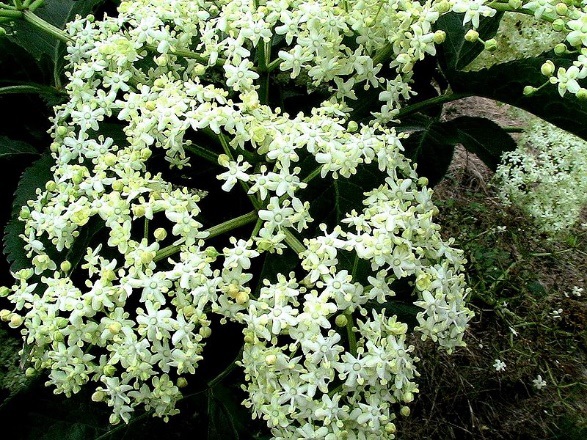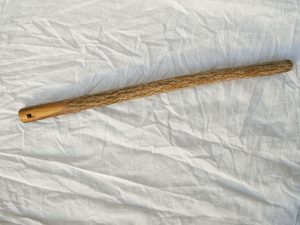Notes from the Apothecary
Notes from the Apothecary: The Elder Tree

We’ve always had elder trees in the garden, for as long as I can remember. As you get to my parents’ house there is one hanging over the privet hedge into the street. The branches home to birds ranging from tiny tits to massive woodpigeons; the roots threatening to burst through the tarmacadam of the pavement. As you walk through the gate there are four more elder trees guarding the side of the house, and every year there is an enormous harvest of both flowers and berries, and still plenty left for the every-hungry birds.
When I was quite small, a dead branch could be hollowed out, as the pithy substance in the twigs is soft and pliable, and so a dead elder branch makes a pretty good pea-shooter. The leaves were always quite noxious when rubbed, so I used to add them to my ‘cauldron’ (a plastic bowl at 5 years old) and pretend I was making a powerful potion. Some things never really change!
My love for this tree has never waned, and even though I have moved away from my parents now, they always save me some flowers and berries, and these are turned into wine, tonics and more.
The flowers are just now starting to transform from tiny green bids to delicate white lace, so I figured now was the best time to tell you all about this magical tree.
The Kitchen Garden
The elder is delightfully edible, both the berries and the flowers, although the berries have an extremely high tannin content so if your stomach can be upset by this (as my very dry red wine or very strong tea) then they are best avoided or at least diluted.
The flowers can be made into fritters, and there is a very lovely recipe for these including tips on when to pick the flowers here in The Guardian.
Elderflowers can also be made into cordial, and are often used to flavour other soft drinks, and also alcoholic ones, such as cider. They can be made into a wine in their own right, and even into something akin to champagne. I achieved this quite by accident last year, due to some secondary fermentation that occurred in the bottle. The end result was that I obtained 5 bottles of rather delicious elderflower champagne, instead of the dry elderflower wine I had originally bottled!
The berries are the darkest red-purple a berry can get, black until you pop them and stain your fingers. They can be made into a kind of loose jam (they don’t set well due to a low pectin content) called a rob, which is closer to a syrup really. I love this recipe on herbal med blog, because of the tip about rinsing the pan out with brandy… then drinking the brandy!
I have a recipe for a tonic which was given to me by a very experienced witch and herbalist, which is for a kind of winter tonic which includes, as well as masses of elderberries, many herbs which reduce coughing, fever and other cold and flu symptoms. I won’t publish it here as it wasn’t given to me to share, however if you can make the elderberry syrup, you can add many other ingredients to boost its potency.
The Apothecary
The tonic I mentioned is so particularly good for the winter months because elderberries have a very potent anti-viral quality. They are particularly effective against chest infections.
Mrs Grieves, in her Modern Herbal, believes all the parts of the tree with the possible exception of the roots to be beneficial in some way.
She tells us that the bark is an excellent emetic and purgative. This tells me that actually, it is probably very poisonous, and the body reacts to that by getting rid of it, and anything else in the stomach, as quickly as possible! She also tells us it is useful in epilepsy and asthma.
The leaves, she insists, must be collected in June and July, in fine weather after the dew has dried the sun. These are then made into an ointment which is useful for bruises, sprains, chilblains and as an emollient. She lists a recipe which includes ground ivy, wormwood and plantain. I would make this type of ointment using only plantain, as the other plants listed are all quite poisonous indeed, and not worth meddling with. Plantain ointment by itself is harmless (as long as you are not allergic) and quite effective.
The flowers are cited as effective in a lotion for the eyes and skin, and the berried should be made into a rob (see above) and used against coughs and colds.
Modern science agrees that the berries are indeed effective against flu-like symptoms, not only reducing the severity of the symptoms but also the length of time the patient must endure them for. Research has also been done into the effects of the elderberry on heart disease, high cholesterol, cancer, constipation, chronic fatigue syndrome and hay-fever, but there is insufficient evidence to support a proven, positive benefit.
Other Uses

Branches of the elder tree are used to make certain musical instruments, such as the Slovakian fujara or koncovka. These instruments are known as ‘shepherd’s flutes’.
The Witch’s Kitchen
Cunningham tells us that the Elder is associated with water, but I have never really understood this. One of the Saxon names from which we get the word elder was Ellhorn, derived from the Saxon word for fire, because the hollow stems could be used for blowing air into the heart of a fire and thus breathing life into the flames. Although the tree is found near water at times, is also found in wasteland, and in gardens miles away from any water source other than hosepipes and rain. All trees represent all the elements at some stage, because of their cyclical nature and the way they change with the seasons (even evergreens have their changes), but to me Elder is more earth and fire than water.
Like the hawthorn, elder is often a hedgerow tree and so the wood, if taken with great care and respect, can be used in liminal rites and magic. It is a good wand for marking out the boundaries of sacred spaces or circles. Never take a branch without permission and never take green, growing wood. The elder is known as a goddess tree and contains divinity and an aspect of the goddess within its roots, branches and leaves. To wound an elder tree is extraordinary bad luck. Around here, in Yorkshire, even though older beliefs have mostly died out, elder trees are one of the few trees that won’t be uprooted to make way for a new path or road. Many times I have seen tarmac laid around the roots of an elder, rather than simply removing the tree, so that the pavement winds around the tree. I can’t help but think that this is a throwback to an older superstition about the ill luck that befalls those who harm the tree.
There are many British folk tales about elder trees who were really witches, who would punish those who harmed them. The tree is innately magical, and a very ancient symbol of magic and witchcraft.
Christianity has not treated the elder kindly, probably due to the magical and mystical associations it carries. Some say that the crucifix Jesus died on was made of elder wood, although I find the logistics of this hard to fathom. The elder is a tiny tree, and crucifixes were massive. It was also said that Judas hung himself from an elder tree, and due to this many Christians believe the tree carries a curse. Again, the logic of this evades me, as surely this means the tree stands for a kind of justice?
A modern witch may use the flowers on early to midsummer altars, to represent air, east, transformation, craft, skill and the planetary association of Venus. The berries come in late summer and may last to early autumn, so can be used as a symbol of earth, the north, blood, knowledge, wisdom, protection, exorcism and feminine mysteries. Elder can be used as protection against malevolent magic, or to bless a sacred space.
Home and Hearth
A Scottish tradition tells that if you stand under an elder tree at Samhain, you may see the faerie cavalcade ride by. I have never done this, but it would be tempting to perform a Samhain rite beneath or near some elder trees, to see if indeed, one could see a little more sharply those that pass from beyond the veil at this time.
For a baby naming ceremony, have the parents bring the baby beneath an elder tree and kiss the trunk, and the baby will be blessed.
A sigil made of elder twigs will protect your home if hung above the door. Choose your own sigil, something important to you, and remember only to take dead twigs or twigs that have already fallen from the tree.
In Scandinavia the wood was used in healing magic, in particular the magic to reduce pain.
A small piece of wood in a pouch can be carried for luck and protection, or for prosperity.
The berries can be crushed and used to stain things red or purple, and also can be used as a magical ink.
Elder is particularly associated with Beltane, again enhancing its association with fire. Normally at this time the flowers have only just started to arrive, so if you are lucky enough to find any, include them in your Beltane rites or altar.
I will be plucking the flowers around midsummer, and will be decorating my own sacred space with them, as well as making wine which will be gifts for my loved ones.
I Never Knew…
A copse of elder trees may indicate a nearby rabbit warren or badger sett, as the animals often unwittingly spread the seeds around where they live by eating the berries.
Mabh Savage is the author of Pagan Portals: Celtic Witchcraft available here.
Image credits: Finfajfilo (Koncovka flute) by Michal Matúšov and Sambucus Nigra by Isidre Blanc both via Wikimedia Commons.